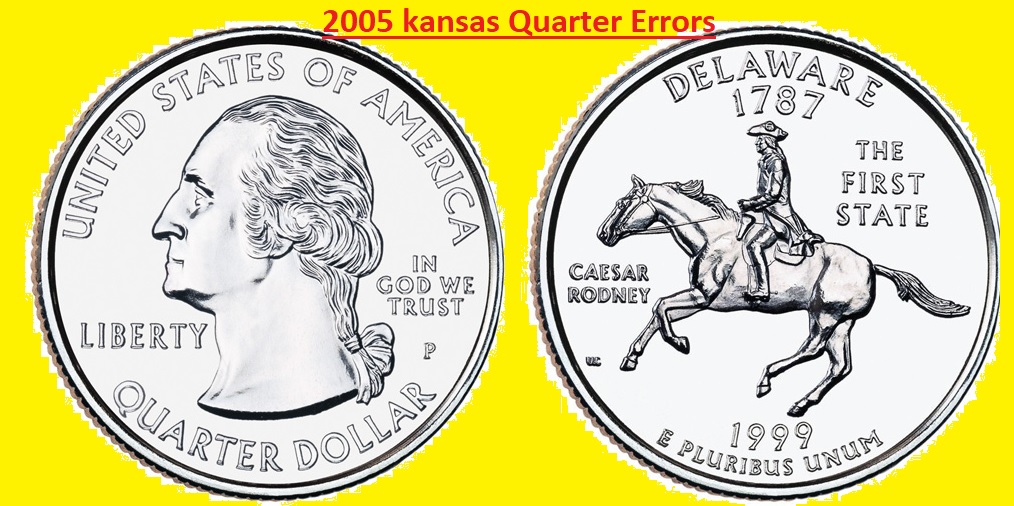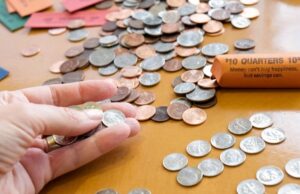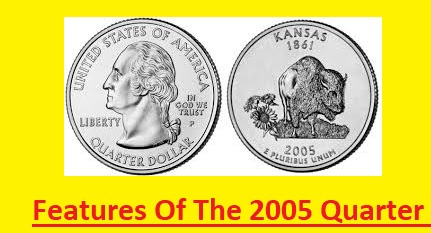Hello friends welcome to the new post. In this post, we will discuss 2005 Kansas Quarter Errors To Look For! Error and Without Errors Value. The standard 2005 Kansas state quarter created with use of clad composition that comes with copper and nickel. Cladproof quarters and silverproof quarters also made. Let’s get started with the 2005 Kansas Quarter
2005 Quarter Details
- This coin is part of the quarter and made by P, D, and S mint.
- A total of 3.03 billion coins were made.
- Its reverse design was made by John Flanagan and its back design was made by different designers
- It has a reeded edge with a diameter of 24.26 millimeters with 1.75 millimeters thickness.
- It has 5.67 grams and is made with 91.67% copper, 8.33% nickel
2005 Kansas State Quarter History
Kansas State quarter 2005 comes with copper and nickel. The US government made quarters with clad proofs and silver proof. These coins come with reverse side buffalo and sunflower. When Kansas became a state buffalo and sunflowers commonly existed.
The year 1861 is written on coins as in this year Kanssa joined the Union for the first time. The USA made a series of Kansas quarters. That is 2005 P, 2005 D, 2005 S proof, and 2005 S silver proof quarters. Proof coins come with larger details thatn regular coins and take longer time to creation since they are made on the special planchet. These coins are made for collectors not for circulation
Common 2005 Kansas quarter error
2005 Kansas Quarter errors are explained here with detailed
IN GOD WE RUST Kansas Quarter Error
This error is the result of grease in the die that obliterated the first letter T of TRUST. In some coins, T can seen but dim. In some coins, T is not visible.
The value of this error is about fifty dollars or higher coins that are uncirculated and not showing T clearly. This error is a commonly circulated type of 2005-P Kansas quarters with the IN GOD WE RUST error having a value of 20 to 30 dollars based on condition.
Humpback Bison Kansas Quarter Error
In this error, the bison on the back side of the quarter is smooth and rounded. On some quarters it looks like a huge tuft of thick hair popping straight up off the bison’s back. It resulted in the die break.
2005-P Kansas Humpback Bison’s quarter value is 100 dollars in uncirculated condition. Circulated type of coins has a value of $15 to $20… or more!
The Spitting Bison Kansas Quarter Error
This error of the Kansas quarter is recently found. It is P minted quarter error also. This error shows to stream of saliva coming from the mouth of the bison and it causes to die break. This coin value is $50 to $100 or more
Related: How Much Does a Dime Weigh?
Features Of The 2005 Quarter
Obverse Of 2005 Quarter
The front side of the 2005 quarter series is the same. It is also like other Washington quarters made since 1932. On this side, there is a photo of Washington’s president. The design was made by John Flanagan and the designer’s initials are also on this side. The word LIBERTY is also on this side with the motto IN GOD WE TRUST added. The denomination “QUARTER DOLLAR”. The mint marks P, D, and S are also on this side.
Reverse Of 2005 Quarter
Differnt reverse design exists such as the California Quarter, which has conservationist, John Muir, gazing at the Yosemite Valle
Minnesota Quarter comes with a tree-linked lake by 2 fishermen and a loon. There is words LAND OF 10,000 LAKES” written there.
Oregon’s desing has a body of water, Crater Lake. That comes with Wizard Island, Watchman, and Hillman Peaks.
The Kansas quarter comes with buffalo on a patch of grass, together with 3 sunflowers.
2005 P Quarter Value
A different number of 2005 quarter made by Philadelphia according to state. California quarters were made about more than 275 million Minnesota quarters are 240 million. Oregon quarter was made about 316 million, and Kansas was about 263 million. West Virginia made about 365 million coins. 2005 quarter are not easily found. Circauled condition value is about face value.
- MS60 2005 P quarter value=3 dollars
- MS63= 4 dollars
- MS65= five dollars
- MS67= 32 dollars
2005 D Quarter Value
Denver mint made 248 million (Minnesota) to 404 million (West Virginia) quarters. In circulated condition their value is about 25 cents.
- MS60 to MS65=$3 to $5.
- California quarter MS67=18 dollars
- Minnesota quarter MS67=$32
- Oregon quarter MS67 = $52.
2005 P And 2005 D Special Strike Quarter Value
The P and D mint made 2005 special strike quarters that have a satin finish for collectors. about 1.16 million coins made from each mint. Their value is
- SP60 = 2 dollars
- SP65=$10 to $18
- SP70 2005 California quarter P mint mark= $1,800
- SP70 2005 California quarter D mint=$4,500.
SP70 2005 California quarter
The S mint made 2005 proof quarters with copper and silver clad. Copper clad about 3,262,960 made for each state.
- PR60=$5 for a clad-proof quarter
- Without error PR70 =$25 (West Virginia)
- Without error PR70= $35 (California and Oregon)
2005 Kansas Quarter Facts
The 2005 Kansas quarter is part of 50 State Quarters series and it is the 34th coin. This series was made from 1999 to 2008. It is a famous coin program that made and helped more than 100 million people to collect state quarters in the starting years of the 2000s.
2005 Kansas quarters comes with a photo of Washington on frontside and the reverse has 2 Kansas state symbols, US bison and sunflowers. This design was made by Norman Nemeth.
The mintage of 2006 Kansas quarter is listed here
- 2005-P Kansas quarter (Philadelphia)= 263,400,000
- 2005-D quarter (Denver) =300,000,000
- 2005-S copper-nickel clad proof quarter = 3,262,960
- 2005-S 90% silver proof quarter = 1,678,649
Read also: How Much Does a Roll of Pennies Weigh
Are 2005 Quarters Silver?
2005 quarter is made with the use of copper with cupronickel cladding. Some proof quarters are made with 90 percent silver and 10 percent copper. The clad quarter has a red or brown edge. Silver coins have mirror finishing. Clad coins weigh about 5.67 grams and silver coins weigh is 6.3 grams
How Much is a 2005 Kansas Quarter Worth?
The 2005 P Kansas quarter and 2005 D Kansas quarter come with a value of 0.30 dollars per quarter. In uncirculated condition MS63 grade, the coin is 0.76. MS65 grade uncirculated coins is about $5.
How much are ‘regular’ Kansas quarters worth?
Worn coins circulated 2005-P and 2005-D Kansas state quarters are not more thatn face value.
uncirculated 2005-P and 2005-D Kansas quarter is fifty cents to one dollar
- circulated 2005-P and 2005-D Kansas state quarters is about face value.
- uncirculated 2005-P and 2005-D Kansas quarters is fifty cents to one dollar
- 2005-S Kansas copper-nickel clad proof quarters value is $1.50 to $5
- 2005-S Kansas 90% silver proof quarters is $5 to $10
- 5-S Kansas copper-nickel clad proof quarters is $1.50 to $5
- 2005-S Kansas 90% silver proof quarters are $5 to $10
What Does the New Kansas Quarter Look Like?
Tallgrass Prairie National Preserve is added on the reverse side of some new Kansas quarter and the quarter comes with a sky view of a regal fritillary butterfly on the back side of the big bluestream. The “TALLGRASS PRAIRIE,” “KANSAS,” “2020,” and “E PLURIBUS UNUM are written there
Read More
A 1979 quarter value/Worth Today
1966 Quarter No Mint Mark (Value, Price Chart, Error List, History & Varieties)
Why is a 1970 Quarter Worth $35,000
FAQs
What are the rare quarters for 2005 Kansas?
There are 3 rare quarters for 2005 Kansas:
- IN GOD WE RUST quarter error:
- Humpback Bison quarter error:.
- Spitting Bison quarter error:
Which state quarter has an error?
- 2004-D Wisconsin Quarter (Extra Leaf) Wisconsin Quarter design, with “High Leaf” and “Low Leaf” errors below.
- 2005-P Minnesota Doubled Die Quarter (Extra Tree) …
- 2005-P Kansas Filled Die Quarter (“IN GOD WE RUST”) ..
- 2006-P Nevada Clipped Planchet Quarter.
What was the error on the 2007 Wyoming quarter?
The error in the stamping process resulted die break between the tail and backside of Wyoming’s bucking horse, that is the result of a mistake placing chunks of metal on coins which is like a Steamboat dropping a steamer.
What are the 10 rarest state quarters?
- 2000 New Hampshire Quarter. …
- 2008 Alaska State Quarter. …
- 1999 Georgia State Quarter. …
- 1999 Delaware State Quarter. …
- 2003 Illinois Quarter (Philadelphia Mint) …
- 2008 Oklahoma Quarter (Philadelphia Mint) …
- 2004 Michigan Quarter (Denver Mint) …
- 2003 Missouri Quarter (Philadelphia Mint)
Which state quarter errors are worth money?
The coins in mint state and marked with D or P can be about 3.50 dollars if they are state design quarter. Ohio quarters with S mark has highest value at $15
How much is a 2005 D quarter worth?
The state quarter 2005 in circulated condition has a value of about 0.30 to 0.40 dollars. The 2005 D quarter in uncirculated condition value is $220.
How much is a 2005 Kansas quarter worth?
The average cost of one silver coin ranges from five to ten dollars based on condition.
What are Kansas quarters?
What is the error on quarters?
Doubled dies:
Off-center strikes: .
Weak strikes:
Struck-through errors:
What is the most expensive error quarter?
A 1796 quarter high value quarter sold at auction for $1.74 million in 2022.
What should I look for in a 2005 quarter?
Most 2005 quarters are made with cupronickel cladding. Some proof quarters are made with 90 percent silver and 10 percent copper. Check the edge of the coins if you seen there is brown or brown or red metal, it’s a clad quarter.
Which quarter is worth $5000?
1965 silver quarter can be of $5,000
How much is 1861 quarter worth?
Seated Liberty Quarter from 1861 in circulated condition is about $25 and $455. 1861 Quarters in pristine, uncirculated condition sell for $42500
What are the rarest error coins?:
The 1943 copper penny with incorrect planchet composition, is a rare coin. The 1943 Copper Penny, is highly preffered by collectors for its scarcity and historical significance.
What state quarters were misprinted?
- 004-D Wisconsin Quarter (Extra Leaf) …
- 2005-P Minnesota Doubled Die Quarter (Extra Tree) …
- 2005-P Kansas Filled Die Quarter (“IN GOD WE RUST”) …
- 2006-P Nevada Clipped Planchet Quarter.
How much is a 2005 California quarter worth?
A State Quarter from 2005 in circulated condition has value of between $0.30 and $0.40. uncirculated condition sell for as much as $220.
Why does the 2005 nickel look different?
Like US Bison NIckel the front side has Thomas Jefferson. The photo is only on 2005 nickels for recognition of Jefferson’s role in the Louisiana Purchase and in commissioning the Lewis and Clark expedition.
What year was the quarter for Kansas issued?
August 29, 2005, this is the 34th coin released in the 50 State Quarters Program and the 4th released in 2005.
- What are the most common quarter errors?
These are double-die errors (where two images are added on the same coin surface), and more. Strike errors. This error occurs when strikes are improperly strike on coin surfaces, such as off-center error
- Why is the 1970 quarter rare?
The 1970 quarter was made when the 1941 Canadian quarter was added in the coin press at S mint to make proof quarters. The remnants of 1941 Canadian qurters can seen on Washington Quarter.
- Why is 1965 quarter so rare?
Silver 1965 quarters are special since they’re transitional error coins.
- What year is the rarest quarter?
1932-D Washington Quarter is a low-mintage coin of about 436,800 pieces, making it a rare coin. These coins of high grade can be sold for $2,000
- What is rare about a 2000 quarter?
- Massachusetts 2000-P (Philadelphia mint) MS69: $3,760.
- Maryland 2000-P MS65: $1,495.
- South Carolina 2000-P MS69: $3,525.
- New Hampshire 2000-D (Denver mint) MS68: $633.
- Virginia 2000-P MS68: $400.
- How much is a 1776 to 1976 quarter worth?
circulated condition is between $0.30 and $0.85. 1776-1976 Quarters in pristine, uncirculated condition sell for $75.
-
What 1999 quarter is worth $10000?
A 1999 Georgia quarter with an experimental planchet error is $10,000.
- What quarter is worth thousands?
1932-D or S Washington Quarter can be of $100, while the uncirculated condition value is $10,000.
-
How much is a 2005 quarter set worth?
2005-P Minnesota quarters with a doubled die error can be of $500.
-
What state quarter has a corn error?
Wisconsin state quarter comes with corn
- What state quarters are worth more than face value?
Ohio quarter marked with S mint has a high value of about 15 dollars. A mint-condition Oklahoma or New Mexico quarter marked with an S could be of $10
- What is the error in the 2004 quarter?
In 2004 many coins of the State Quarters series were made with misprints on the design for the Wisconsin coin. These coins has an extra leaf on the left side of the corn cab on coin. These coins are high value and sell for several hundred dollars.










Hi. I have a 2005 Kansas quarter and has a Error that is not described or talked about. Would like to show and thinking it will be a WOW. And get ones attention. The coin is in extra fine condition. Thank you.